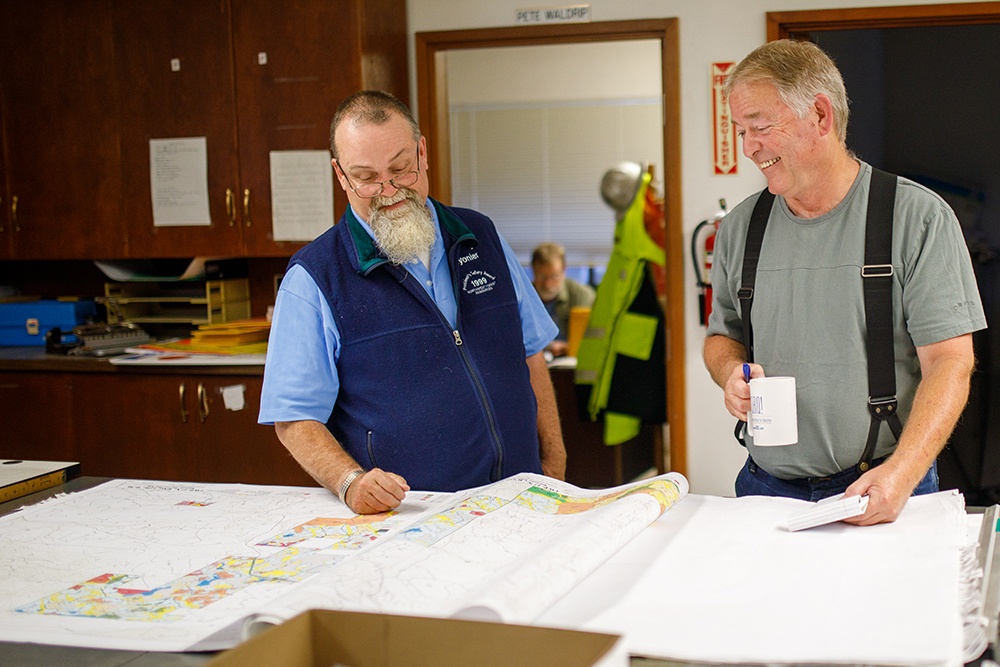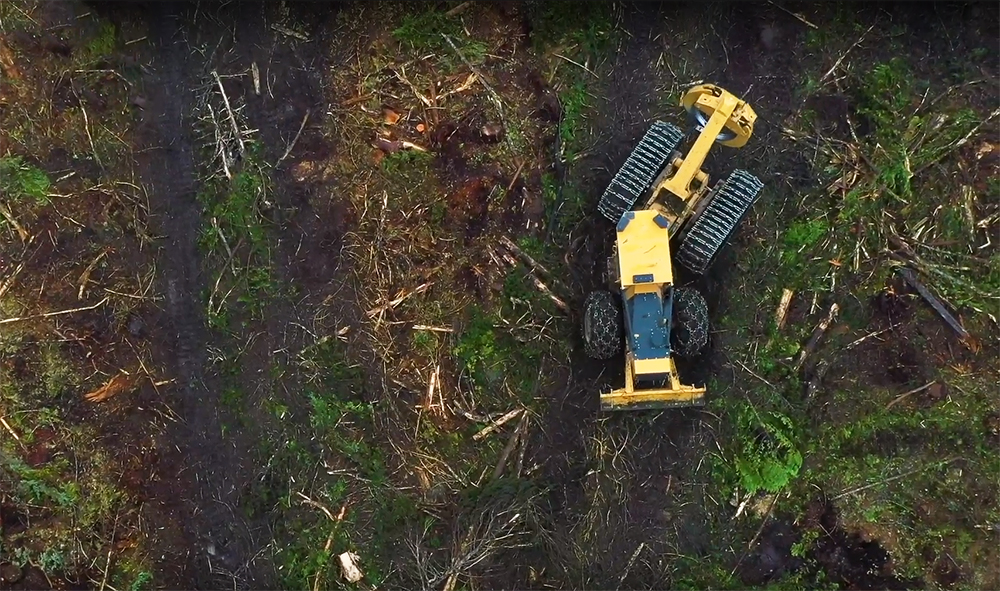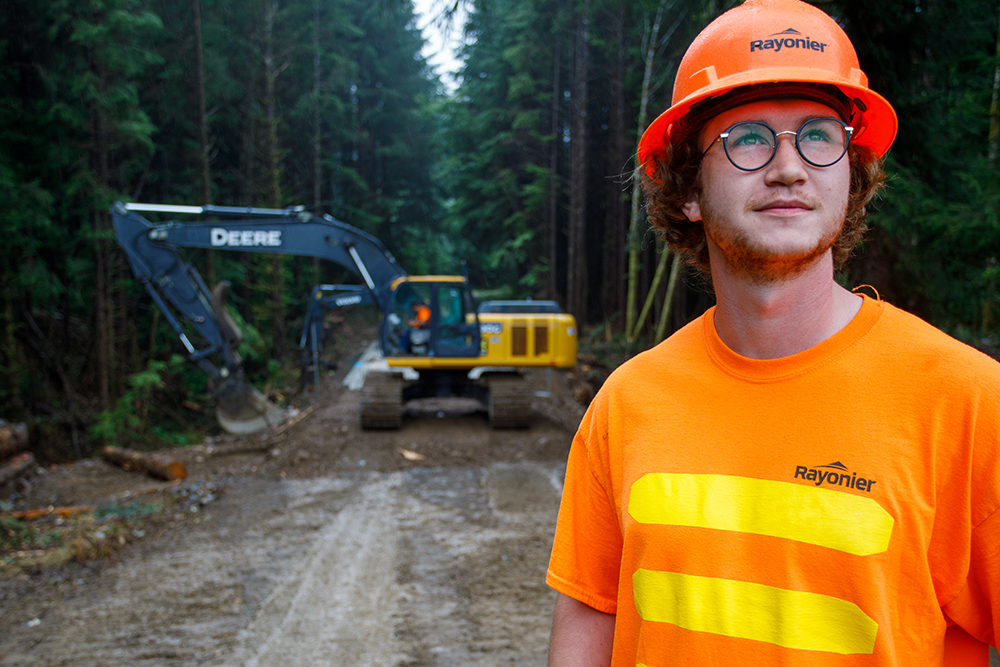Rayonier relies on a talented team of forest engineers to plan harvests and maintain our private roads and bridges across hundreds of thousands of acres in the Pacific Northwest, always with protecting the environment in mind.
FORKS and HOQUIAM, Washington—Imagine the amount of infrastructure required to reach the timber on hundreds of thousands of acres of mountainous land.
In the U.S. Pacific Northwest, Rayonier has a massive network of private roads and bridges stretching across nearly 400,000 acres of forest land. In order to maintain our infrastructure to the best possible standards for the environment while also doing what’s best for our timber operations, we rely on a talented team of forest engineers.

“Timber without access has no commercial value, so our job is to access timber and then to maintain the infrastructure required for that access,” explains Engineering Manager Mark Smalley, who oversees the team. The forest engineers build and maintain roads and bridges, create a plan for each timber harvest and source money-saving rock pits on our land to provide some of our road-building materials.
When it comes to roads, they don’t just seek the cheapest, simplest route to each stand of trees. They look for the method that will impact the environment the least, doing extensive research to ensure their plans won’t deposit sediment in waterways, cause erosion that would strip the rich soil from the land, or interfere with the ecosystems in the streams and rivers they cross.
“I think it’s very important that we manage the lands properly,” says Field Engineer Mike Leavitt, a lifelong resident of Forks. “We need to have the continuance for sustainability out here because I want my community to survive, and Rayonier’s a big part of this community.”
Harvest Planning a Complex Task
“The most important thing we do is the harvest planning,” says Pete Waldrip, who’s been a Rayonier Forest Engineer for 39 years. “We make sure that we’re harvesting the right timber at the right time for the right market and adhering to our goals as a company.”
The work is complex. A forest engineer must locate timber that meets the market’s demand for a specific species, age, size and quality of wood. Then, the infrastructure needed to reach that stand of trees must be in place. The trees may be many miles from a public road, meaning the engineer has to ensure the roads and bridges leading to that stand are adequate for the work and also compliant with environmental standards. In addition, the engineer will work with a logging company to configure the best way to harvest the trees, keeping in mind the complications added by the steep slopes in the Pacific Northwest. A harvest operation on a steep slope requires careful planning to ensure the safety of the logging crew and to minimize erosion.
Partnering with Contractors to Solve Problems
Forest Engineer Wendi Lubinus recently worked with a longtime Rayonier partner, RL Smith Logging Inc., to identify stands of trees that could be harvested with fewer roads than typical.
“We purchased a six-wheel-drive skidder from Tigercat a couple years ago and I brought that to the attention of a couple landowners,” says Roger Smith, who owns the logging company. The skidder, outfitted with tracks, can cover a larger area of land without damaging the soil bed and causing erosion the way a more traditional skidder would.
“It was a really good collaborative effort between us and the logger,” Wendi said during a recent visit to a harvest site near Hoquiam, where Smith’s team was using the skidder.

Doing Better with Less
Like detectives for the land, forest engineers explore properties, review maps and consult with experts to determine how to do the most good with the least amount of infrastructure. Sometimes they find ways to close old forest roads altogether.
“It’s an impact on the environment, but it’s also land out of production,” explains Wendi.
She says there are instances when she’s able to close old forest roads and replant with trees for future generations. Other roads are closed so old culverts can be removed, eliminating interference with upland streams.
Restoring Salmon Population an Integral Part of Forest Engineering
Forest Engineer Matt Poppe spends all of his time reviewing and either replacing or eliminating road crossings to ensure the best possible fish passage conditions. A century ago, foresters built roads without realizing how detrimental they would be to the ecosystems in the streams they crossed. They placed culverts under the roadways, believing that would be enough to allow the streams to continue to flow naturally. But more often than not, those culverts were too small, blocking the natural flow of water certain times of year. That prevented salmon from reaching the upland streams that are so critical for breeding and rearing their young.
Poppe says Rayonier has replaced 750 culverts and bridges in the past 20 years, opening more than 220 miles of fish habitat.
The program operates under the guidance of Washington’s Forests & Fish Law. Learn more about it in our article, How Foresters Restore Salmon Habitat in the Pacific Northwest.

The Next Generation of Forest Engineers
With some forest engineers who have been with the company for three and four decades, and others who are only a year or two out of college, Rayonier has benefitted from generations of engineers learning from one another.
Engineers like Mike and Pete have a reputation in the company—and the community—for their vast knowledge of both the land and the environmental guidelines for managing the land. Younger engineers, like Griffin Ollar and Chris Janik, more recent college graduates who studied Forest Engineering in their respective colleges, are bringing a new perspective, adding a level of technological expertise that has impressed their counterparts on the engineering team.
“It’s great to see not only the younger employees learn from the older employees, but to also see the older learn from the younger,” Smalley says. “We have a diverse group of employees on this team, and we’ve really benefited from that collaboration.”





Leave a Comment